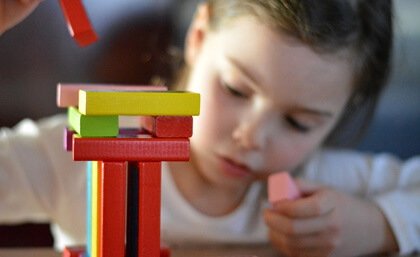Divergent Thinking in Children


Written and verified by the psychologist Valeria Sabater
Divergent thinking in children is an exceptional gift. Their open mind is full of possibilities and unusual, original, and constant idiosyncratic reasoning. However, sometimes that creative potential disappears when children grow up in an educational system that standardizes the mindset of all students, unifying their perspectives.
Most of us know that having the courage to think differently is dangerous. Galileo, for example, discovered this the hard way since he had to live out the final years of his life confined to a house in Florence due to his ideology. Open minds are those who defy the world, there’s no doubt, but they also help people move forward.
Sir Kenneth Robinson
Clearly, times have changed and we don’t have to worry too much about living out our final days like Galileo, as such things no longer happen. However, other bad things do happen. As noted by Sir Kenneth Robinson, a widely recognized education expert, today’s schools are killing children’s creativity.
According to him, our educational centers base their curriculums on nineteenth-century systems from a time when the industrialization of society meant that some capacities were more valued over others. Promoting innovation, creativity, or critical thinking wasn’t important as those times were characterized by a hierarchy of subjects and very rigid competencies.
We forget that children come into the world equipped with extraordinary talents. We overlook the potential of their divergent thinking, that extraordinary gift we kill by “educating” them in convergent thinking.
“It’s not what you look at that matters, it’s what you see.”
-Henry David Thoreau-

Divergent thinking in children
Henry David Thoreau was, without a doubt, one of the most revolutionary philosophers. He’s a figure who clearly displayed divergent thought. This is apparent in his unusual ideas about freedom and responsibility. Going back to his texts from time to time is a great way to find inspiration.
He taught us that life is a blank canvas for the imagination. He also helped us realize that people are born with music inside them and that we have to let people be themselves because freedom leads to self-growth. The same thing goes for children. And yet, we’re not always able to hear the magical melody and the incredible potential hidden inside every child.
Dr. Leonard Brzozowski
Dr. Leonard Brzozowski, an expert in the field, pointed out something interesting that he discovered when he conducted a study along with psychologists George Land and Beth Jarman. The book Breakpoint and Beyond: Mastering the Future Today contains their findings.
- Divergent thinking in 5-year-old children scores similarly to adults with high intellectual abilities. Thus, when these little ones were asked in how many ways they could use a cup, a pencil, or a shoe, they gave up to 100 valid answers. An adult usually gives about 10-12 valid answers.
- Now, if we make a 10-year-old child take a divergent thinking test, we’ll realize that this potential has reduced by approximately 60%.

Preschoolers are real geniuses
When children between the ages of 4 and 6 take divergent tests, they score really high. Álvaro Pascual-Leone, Professor of Neurology at Harvard Medical School, pointed out that synaptic pruning in the brain is common at this age.
During this stage, programmed neuronal pruning can be modified only through experience. If there are no adequate stimuli, the cell pruning will limit a lot of the child’s learning potential as time goes by.
It’s not necessarily about having “many neuronal connections.” The key is to optimize that pruning with the most appropriate learning methods and through stimulation, especially between the ages of 4 and 6 years when children’s potential is intact and at its fullest.
How to protect and enhance divergent thinking
- Immersive learning. Children must experiment, feel, touch, and get excited.
- The children should do some of these experiments in a group with their peers. However, we should also encourage autonomous work often and provide a space of their own where they can exercise their creativity.
- Likewise, they need to learn that there isn’t just one single answer to anything. Divergent thinking generates multiple solutions to a single problem. When you sanction children’s ideas often and label them as “incorrect” or “wrong,” you unmotivate them to think differently. Or, at the very least, you lower their confidence to say what they’re truly thinking.
- To enhance divergent thinking in children, it’s also necessary for them to feel emotionally validated. Feeling they’re accepted, respected, valued, and loved will help them gain the confidence to explore. Knowing they won’t be criticized will allow them to discover new interests, answers, ideas, and original reasoning.
Conclusion
Finally, it should be noted that encouraging and protecting divergent thinking doesn’t mean that you should completely eliminate convergent thinking. Actually, it’s about balancing analytical and creative thinking. Sometimes, there are problems that do require a specific solution. This is why children should understand when it’s appropriate to apply them.
Furthermore, we should optimize divergent thinking in our children. As Albert Einstein said: “Everyone is a genius. But if you judge a fish by its ability to climb a tree, it will live its whole life believing that it is stupid.”
Divergent thinking in children is an exceptional gift. Their open mind is full of possibilities and unusual, original, and constant idiosyncratic reasoning. However, sometimes that creative potential disappears when children grow up in an educational system that standardizes the mindset of all students, unifying their perspectives.
Most of us know that having the courage to think differently is dangerous. Galileo, for example, discovered this the hard way since he had to live out the final years of his life confined to a house in Florence due to his ideology. Open minds are those who defy the world, there’s no doubt, but they also help people move forward.
Sir Kenneth Robinson
Clearly, times have changed and we don’t have to worry too much about living out our final days like Galileo, as such things no longer happen. However, other bad things do happen. As noted by Sir Kenneth Robinson, a widely recognized education expert, today’s schools are killing children’s creativity.
According to him, our educational centers base their curriculums on nineteenth-century systems from a time when the industrialization of society meant that some capacities were more valued over others. Promoting innovation, creativity, or critical thinking wasn’t important as those times were characterized by a hierarchy of subjects and very rigid competencies.
We forget that children come into the world equipped with extraordinary talents. We overlook the potential of their divergent thinking, that extraordinary gift we kill by “educating” them in convergent thinking.
“It’s not what you look at that matters, it’s what you see.”
-Henry David Thoreau-

Divergent thinking in children
Henry David Thoreau was, without a doubt, one of the most revolutionary philosophers. He’s a figure who clearly displayed divergent thought. This is apparent in his unusual ideas about freedom and responsibility. Going back to his texts from time to time is a great way to find inspiration.
He taught us that life is a blank canvas for the imagination. He also helped us realize that people are born with music inside them and that we have to let people be themselves because freedom leads to self-growth. The same thing goes for children. And yet, we’re not always able to hear the magical melody and the incredible potential hidden inside every child.
Dr. Leonard Brzozowski
Dr. Leonard Brzozowski, an expert in the field, pointed out something interesting that he discovered when he conducted a study along with psychologists George Land and Beth Jarman. The book Breakpoint and Beyond: Mastering the Future Today contains their findings.
- Divergent thinking in 5-year-old children scores similarly to adults with high intellectual abilities. Thus, when these little ones were asked in how many ways they could use a cup, a pencil, or a shoe, they gave up to 100 valid answers. An adult usually gives about 10-12 valid answers.
- Now, if we make a 10-year-old child take a divergent thinking test, we’ll realize that this potential has reduced by approximately 60%.

Preschoolers are real geniuses
When children between the ages of 4 and 6 take divergent tests, they score really high. Álvaro Pascual-Leone, Professor of Neurology at Harvard Medical School, pointed out that synaptic pruning in the brain is common at this age.
During this stage, programmed neuronal pruning can be modified only through experience. If there are no adequate stimuli, the cell pruning will limit a lot of the child’s learning potential as time goes by.
It’s not necessarily about having “many neuronal connections.” The key is to optimize that pruning with the most appropriate learning methods and through stimulation, especially between the ages of 4 and 6 years when children’s potential is intact and at its fullest.
How to protect and enhance divergent thinking
- Immersive learning. Children must experiment, feel, touch, and get excited.
- The children should do some of these experiments in a group with their peers. However, we should also encourage autonomous work often and provide a space of their own where they can exercise their creativity.
- Likewise, they need to learn that there isn’t just one single answer to anything. Divergent thinking generates multiple solutions to a single problem. When you sanction children’s ideas often and label them as “incorrect” or “wrong,” you unmotivate them to think differently. Or, at the very least, you lower their confidence to say what they’re truly thinking.
- To enhance divergent thinking in children, it’s also necessary for them to feel emotionally validated. Feeling they’re accepted, respected, valued, and loved will help them gain the confidence to explore. Knowing they won’t be criticized will allow them to discover new interests, answers, ideas, and original reasoning.
Conclusion
Finally, it should be noted that encouraging and protecting divergent thinking doesn’t mean that you should completely eliminate convergent thinking. Actually, it’s about balancing analytical and creative thinking. Sometimes, there are problems that do require a specific solution. This is why children should understand when it’s appropriate to apply them.
Furthermore, we should optimize divergent thinking in our children. As Albert Einstein said: “Everyone is a genius. But if you judge a fish by its ability to climb a tree, it will live its whole life believing that it is stupid.”
All cited sources were thoroughly reviewed by our team to ensure their quality, reliability, currency, and validity. The bibliography of this article was considered reliable and of academic or scientific accuracy.
- Gopnik, A. (2013). Pensamiento científico en niños pequeños. ScienceDaily , 1623 (2012), 16. https://doi.org/10.1126/science.1223416
- Madore, K. P., Jing, H. G., & Schacter, D. L. (2016). Divergent creative thinking in young and older adults: Extending the effects of an episodic specificity induction. Memory and Cognition, 44(6), 974–988. https://doi.org/10.3758/s13421-016-0605-z
- Runco, MA (1993). Pensamiento divergente, creatividad y superdotación. Niño superdotado trimestral , 37 (1), 16–22. https://doi.org/10.1177/001698629303700103
This text is provided for informational purposes only and does not replace consultation with a professional. If in doubt, consult your specialist.







